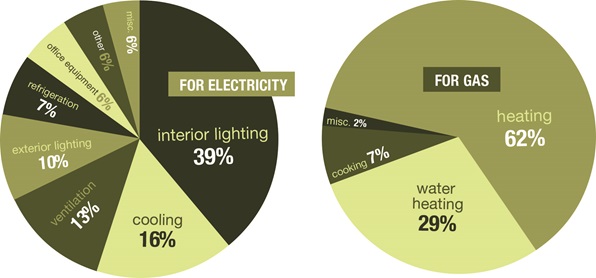A bright idea: Prop. 39 powers up school savings by driving down energy costs
By:
Scott LaFeeFall 2013
 Here’s a statistic both illuminating and educational: California’s 11,000 public schools spend as much each year on lighting, heating and cooling as they do on books and supplies—about $700 million. And roughly a third of that power, according to the U.S. Department of Energy, is wasted—used inefficiently or unnecessarily.
Here’s a statistic both illuminating and educational: California’s 11,000 public schools spend as much each year on lighting, heating and cooling as they do on books and supplies—about $700 million. And roughly a third of that power, according to the U.S. Department of Energy, is wasted—used inefficiently or unnecessarily.
Proposition 39, also known as the California Clean Energy Jobs Act, is intended to change that fact in singular, dramatic fashion, not unlike swapping an old incandescent bulb for an LED light that burns brightly (and cheaply) for years.
“There’s never been anything like this,” declares Bill McGuire, superintendent of the St. Helena Unified School District, about an hour north of San Francisco. “Every school district has energy issues, but the state has tended to view it as each district’s problem. Whether districts resolved their energy issues usually depended on whether they could come up with the money to pay for the solutions.”
Proposition 39 comes up with the money. Approved overwhelmingly by voters last year— 61.1-38.9 percent—it closes a loophole that had allowed out-of-state corporations doing business in California to pay lower income tax rates.
The resulting reward is expected to be massive: $1.1 billion in new state revenue annually.
For the next five years, half of that money will be directed at improving energy efficiencies and expanding alternative energy use (typically solar) in public schools, universities, colleges and other public buildings, while simultaneously maximizing energy and employment benefits. The other half goes to the state’s beleaguered and bereft treasury.
The five-year total for education is projected to be $2.75 billion. The state Legislative Analyst’s Office estimates Proposition 39-associated projects will generate up to 40,000 additional jobs, primarily in energy-related businesses and industries.
The public push for cleaner, more efficient energy use isn’t new, of course. In 2006, for example, the California Global Warming Solutions Act mandated that K-12 schools, colleges, universities and all state-run facilities document carbon emissions associated with facility operations by 2010, reduce CO2 emissions from educational buildings to 30 percent of 1990 levels by 2020 and achieve an 80 percent reduction by 2050.
Also in 2006, the Kindergarten-University Public Education Facilities Bond Act (which passed with 56 percent of the vote) included $100 million (out of a $10.4 billion total) for high-performance schools. Most of that funding, however, targeted new construction and general modernization.
|
| |
Getting schooled on energy costs
According to Pacific Gas and Electric research, energy use in schools breaks down this way:
|
|
 |
|
|
Lowering actual energy bills isn’t a particularly sexy topic, and efforts to do so have tended to be localized, uneven and often overshadowed by higher-profile, more pressing concerns.
“A lot of people who might have done this work were let go during the recent years of budget crises,” observes Jody London, a school board member with the Oakland Unified School District and longtime activist on energy issues.
“The emphasis has been on saving classroom jobs and other academic issues, though I would argue that these kinds of jobs—operating and managing energy—are also important to education. They help ensure we provide a healthy learning environment, which is good for everybody—students and teachers.”
Cutting costs through energy improvements is hugely attractive for schools and, in some ways, a lot simpler than other savings efforts, according to Anna Ferrara, executive director of the School Energy Coalition, an organization that promotes more efficient, cleaner energy technologies in schools.
“Energy can be a very high line item on the discretionary budget,” she says.
Indeed, a Pacific Gas & Electric Co. analysis estimated that the cost of energy accounts for just 1 to 2 percent of most school budgets but represents 16 percent of controllable operational costs.
Prop 39 Eligibility criteria
Proposition 39 funding comes “at an especially opportune time,” according to Julia Zuckerman and Jeff Deason, researchers at the Climate Policy Initiative, an international think tank with offices in San Francisco. “School districts are looking for the opportunity to save money and interest rates are low, which puts more projects in reach for many school districts. This means that, for example, a school district could use Proposition 39 grants to cover a portion of a project and use a low-cost loan, public or private lease-purchase agreement, to cover the remainder.”
Which begs a question: How will schools spend the money?
And its follow-up: Will they spend it smartly?
Proposition 39’s eligibility criteria are fairly straightforward:
- Projects must be cost-effective.
- Projects must focus on energy efficiency and demand reductions first.
- All projects shall require contracts that identify specifications, costs and projected energy savings.
- Recipients agree to submit to financial audits, to make information such as facilities data available to program evaluators and provide information required by an annual expenditure report.
Given the diversity and disparities among districts throughout the state, Proposition 39 seeks no specific goals for energy efficiency or savings. Districts are obliged to estimate the projected value of their improvements, with audits to confirm them. There is no stipulated punishment for falling short, points out McGuire, St. Helena’s superintendent, “other than having to publicly explain why to your community.”
In working out how Proposition 39 will be implemented, some observers have voiced concerns that some school districts might use their funds injudiciously, opting perhaps for big-ticket projects that don’t produce the broadest, maximum energy savings as a less glitzy effort or becoming overwhelmed by an anticipated wave of opportunities, vendors and sales pitches.
Oakland school board member London has been involved in developing state energy policies since 1990 and once worked with the California Public Utilities Commission. She says her experience suggests many school boards don’t enjoy much depth of knowledge when it comes to energy issues.
“Most districts don’t really have the expertise or funding to seriously manage energy policy,” she says. “I worry that some won’t be able to effectively wade through the barrage of vendors and marketers.”
McGuire expresses more confidence. “I’ve worked in school districts large and small, and schools have been dealing with energy issues and needs for more than a century. All they need is good information, and that’s one thing schools do very well—share information. I think you’ll see folks trading best practices, advice—working together to maximize benefits.”
And energy issues can be addressed effectively at any scale, according to Aaron Jobson, a principal in Quattrocchi Kwok Architects, a Santa Rosa-based firm specializing in school construction.
“Small school districts should start by completing a simple benchmarking of their facilities to identify one facility to address, then conduct an energy audit of that facility to identify which improvements will save the most energy,” he suggests.
The audit can be done by a professional company or through the California Energy Commission’s Bright Schools Program, Jobson says. Proposition 39 sets aside funds to help pay for some audits. The Bright Schools Program is offered at no cost. Many local utilities offer free or reduced-cost energy audits. The School Energy Coalition and other groups are also gearing up efforts to provide advice and assistance to local educational agencies.
McGuire expects most districts will take a measured approach to spending their Proposition 39 funds, focusing on three primary areas:
- Conservation
- Retrofit
- Supply
The first may be toughest, he warns. Conservation is largely a behavioral issue. It’s easy to swap out light bulbs, harder to get users to remember to turn them off. “In public settings, people don’t think about who’s paying,” he says.
Most retrofit projects, McGuire predicts, are likely to address well-known or longstanding needs: “Things that districts haven’t been able to repair or replace due to lack of funds. They’ll do it now with more energy-efficient alternatives.”
Supply, McGuire continues, relates to major efforts, such as switching to solar or renewable energy sources. “Everybody wants to do them. They’re exciting. But you have to do the other two as well.”
The passage of Proposition 39 and its anticipated windfall presents an extraordinary opportunity to address significant energy issues. Five years from now, how will success be measured?
Zuckerman and Deason at CPI say at the most basic level, all districts in the state will be participating in energy savings programs and receiving the assistance they need: “There won’t be any money left on the table.”
Schools will have completed or be in the process of completing substantial, high-quality, long-lasting energy-saving projects that would not have occurred without Proposition 39 funds.
“We should see a lot more of these projects over the next five years than are being done now,” Zuckerman and Deason say, “especially projects that are more comprehensive and deliver long-term energy savings. Where the project economics work out, Proposition 39 projects should adopt whole-building approaches to achieve significant energy performance improvements. For example, by reducing HVAC demand through building shell improvements and controls, then sizing smaller new HVAC systems to reflect that reduced demand.”
Five years from now, schools should be enjoying measurable savings on their energy bills, with the money flowing back into general budgets to support students and learning, lighting the way, perhaps, to even more ambitious efforts and greater benefits.
Scott LaFee is a frequent contributor to California Schools.
Prop. 39 tools
CSBA’s own website is the best place to begin tapping the resources of energy efficiency. Go to www.csba.org and click on the Products & Services tab, then Facilities & Energy Efficiency. There you’ll find the CSBA Partners described on page 30 of the print edition:
Ameresco Inc., Sunpower Inc., Schools Targeted Energy Program
State agencies
California Energy Commission | www.energy.ca.gov/efficiency/proposition39
This state agency’s California Clean Energy Jobs Act Web page has answers to Frequently Asked Questions about Proposition 39 and a listserv to keep you up-to-date.
Sustainable Schools | www.sustainableschools.dgs.ca.gov/sustainableschools
Part of the Division of the State Architect, this resource has an information-rich section on energy featuring links to many like-minded agencies and programs.
Nonprofits
Cool California | www.coolcalifornia.org
This partnership of government agencies, universities and nonprofits promotes energy savings and efficiencies. The Schools tab on its website has resources for students, teachers and administrators (and governance teams)—including a “funding wizard” that aids the search for grant, incentive and rebates for sustainable projects.
Center for Green Schools | www.centerforgreenschools.org
This well-stocked information clearinghouse has a special section just for K-12 schools, covering the what, why and how of what makes a school “green” (environmentally friendly).
School Energy Coalition | www.schoolenergysolutions.org
“The School Energy Coalition is dedicated to funding for school projects that will reduce energy usage, save money and produce clean renewable power for our students and communities throughout California, according to the website, which also offers a free newsletter and other resources.